relay CHRYSLER VOYAGER 2001 Owner's Manual
[x] Cancel search | Manufacturer: CHRYSLER, Model Year: 2001, Model line: VOYAGER, Model: CHRYSLER VOYAGER 2001Pages: 4284, PDF Size: 83.53 MB
Page 238 of 4284
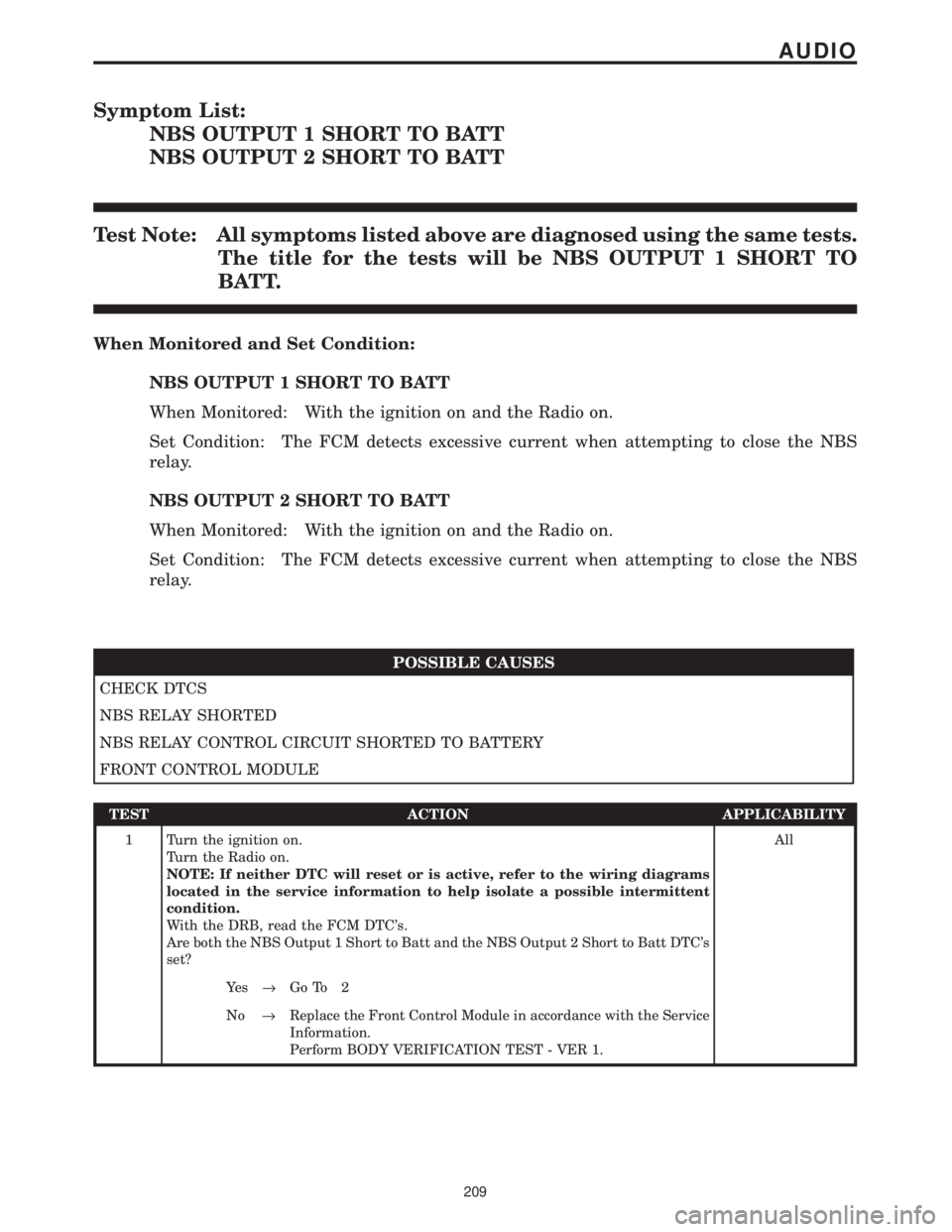
Symptom List:
NBS OUTPUT 1 SHORT TO BATT
NBS OUTPUT 2 SHORT TO BATT
Test Note: All symptoms listed above are diagnosed using the same tests.
The title for the tests will be NBS OUTPUT 1 SHORT TO
BATT.
When Monitored and Set Condition:
NBS OUTPUT 1 SHORT TO BATT
When Monitored: With the ignition on and the Radio on.
Set Condition: The FCM detects excessive current when attempting to close the NBS
relay.
NBS OUTPUT 2 SHORT TO BATT
When Monitored: With the ignition on and the Radio on.
Set Condition: The FCM detects excessive current when attempting to close the NBS
relay.
POSSIBLE CAUSES
CHECK DTCS
NBS RELAY SHORTED
NBS RELAY CONTROL CIRCUIT SHORTED TO BATTERY
FRONT CONTROL MODULE
TEST ACTION APPLICABILITY
1 Turn the ignition on.
Turn the Radio on.
NOTE: If neither DTC will reset or is active, refer to the wiring diagrams
located in the service information to help isolate a possible intermittent
condition.
With the DRB, read the FCM DTC's.
Are both the NBS Output 1 Short to Batt and the NBS Output 2 Short to Batt DTC's
set?All
Ye s®Go To 2
No®Replace the Front Control Module in accordance with the Service
Information.
Perform BODY VERIFICATION TEST - VER 1.
209
AUDIO
Page 239 of 4284
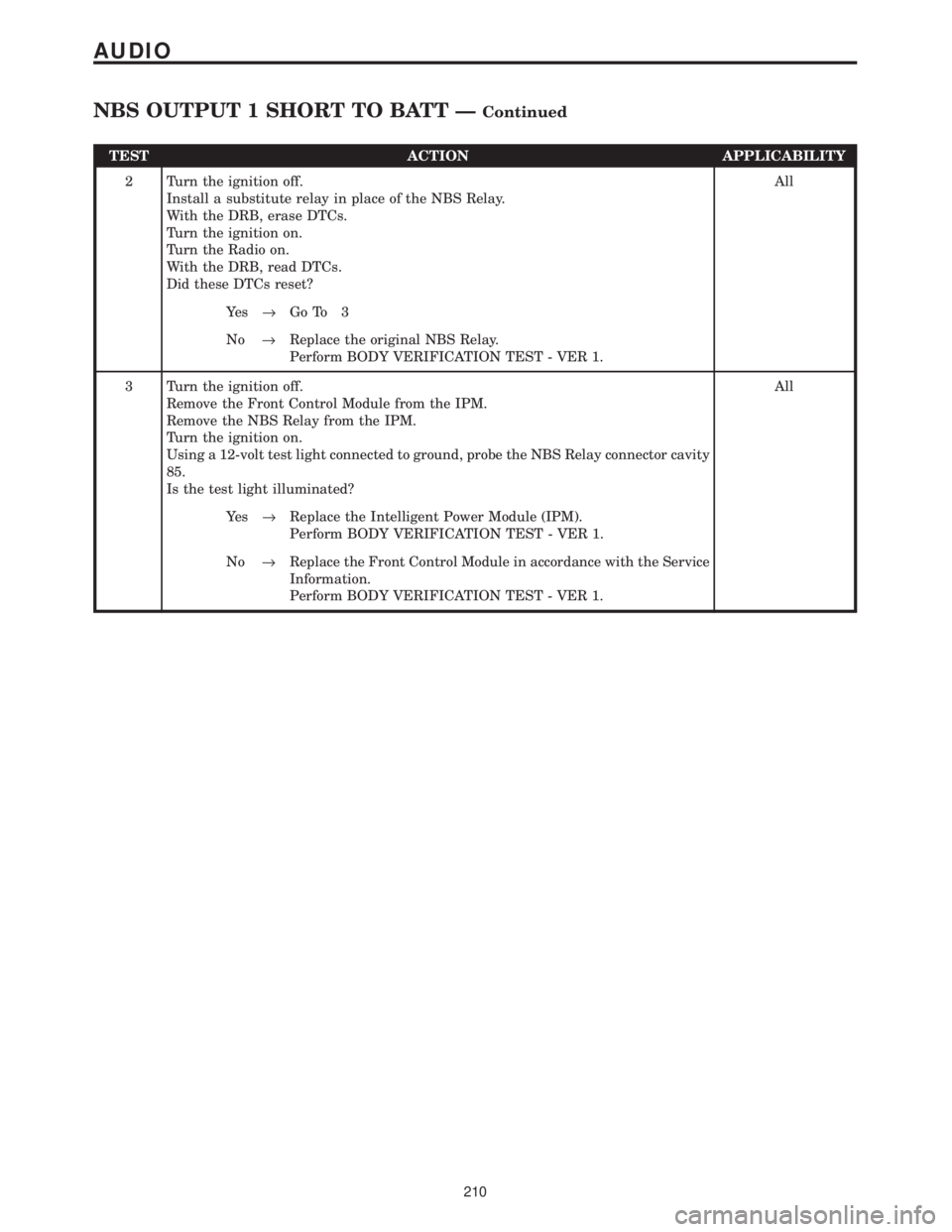
TEST ACTION APPLICABILITY
2 Turn the ignition off.
Install a substitute relay in place of the NBS Relay.
With the DRB, erase DTCs.
Turn the ignition on.
Turn the Radio on.
With the DRB, read DTCs.
Did these DTCs reset?All
Ye s®Go To 3
No®Replace the original NBS Relay.
Perform BODY VERIFICATION TEST - VER 1.
3 Turn the ignition off.
Remove the Front Control Module from the IPM.
Remove the NBS Relay from the IPM.
Turn the ignition on.
Using a 12-volt test light connected to ground, probe the NBS Relay connector cavity
85.
Is the test light illuminated?All
Ye s®Replace the Intelligent Power Module (IPM).
Perform BODY VERIFICATION TEST - VER 1.
No®Replace the Front Control Module in accordance with the Service
Information.
Perform BODY VERIFICATION TEST - VER 1.
210
AUDIO
NBS OUTPUT 1 SHORT TO BATT ÐContinued
Page 325 of 4284
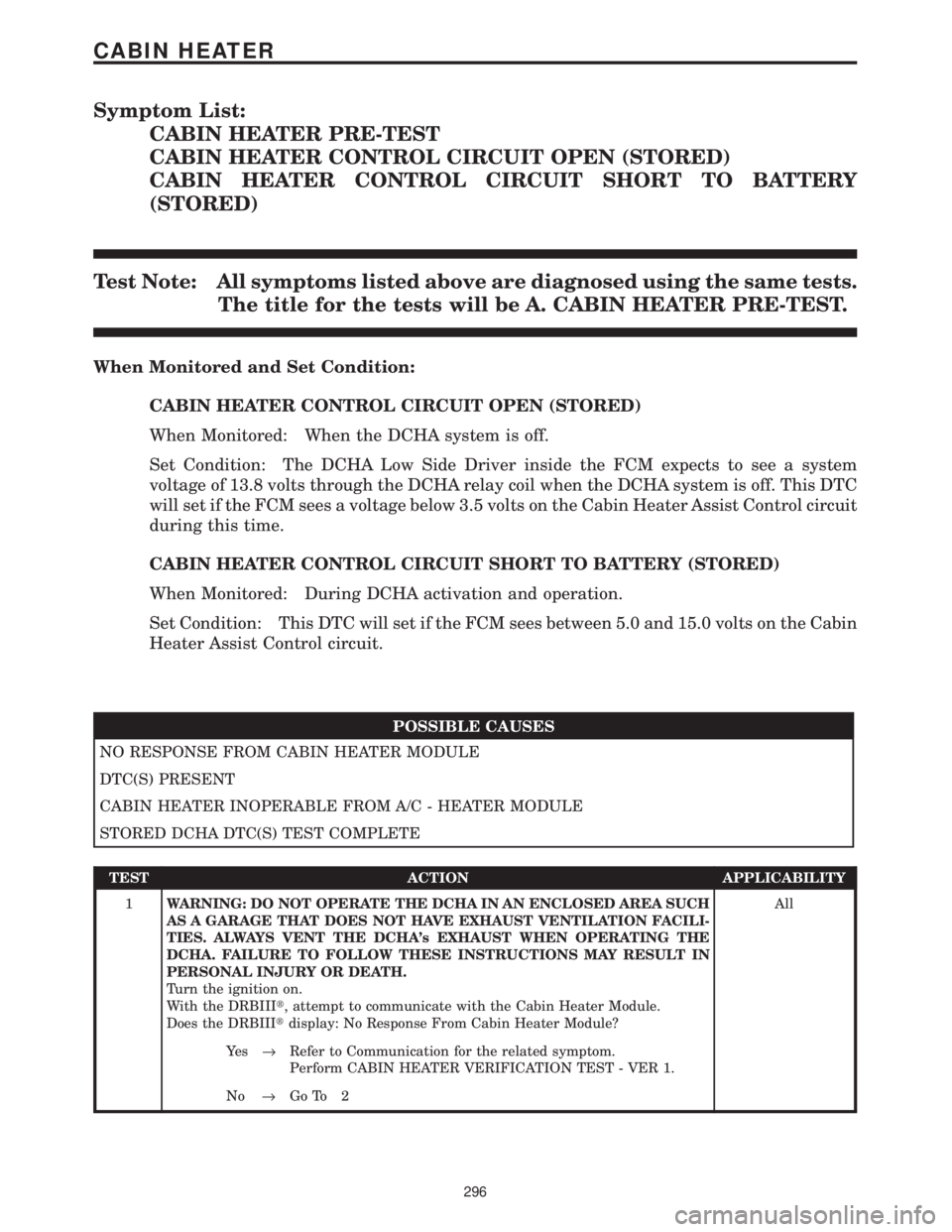
Symptom List:
CABIN HEATER PRE-TEST
CABIN HEATER CONTROL CIRCUIT OPEN (STORED)
CABIN HEATER CONTROL CIRCUIT SHORT TO BATTERY
(STORED)
Test Note: All symptoms listed above are diagnosed using the same tests.
The title for the tests will be A. CABIN HEATER PRE-TEST.
When Monitored and Set Condition:
CABIN HEATER CONTROL CIRCUIT OPEN (STORED)
When Monitored: When the DCHA system is off.
Set Condition: The DCHA Low Side Driver inside the FCM expects to see a system
voltage of 13.8 volts through the DCHA relay coil when the DCHA system is off. This DTC
will set if the FCM sees a voltage below 3.5 volts on the Cabin Heater Assist Control circuit
during this time.
CABIN HEATER CONTROL CIRCUIT SHORT TO BATTERY (STORED)
When Monitored: During DCHA activation and operation.
Set Condition: This DTC will set if the FCM sees between 5.0 and 15.0 volts on the Cabin
Heater Assist Control circuit.
POSSIBLE CAUSES
NO RESPONSE FROM CABIN HEATER MODULE
DTC(S) PRESENT
CABIN HEATER INOPERABLE FROM A/C - HEATER MODULE
STORED DCHA DTC(S) TEST COMPLETE
TEST ACTION APPLICABILITY
1WARNING: DO NOT OPERATE THE DCHA IN AN ENCLOSED AREA SUCH
AS A GARAGE THAT DOES NOT HAVE EXHAUST VENTILATION FACILI-
TIES. ALWAYS VENT THE DCHA's EXHAUST WHEN OPERATING THE
DCHA. FAILURE TO FOLLOW THESE INSTRUCTIONS MAY RESULT IN
PERSONAL INJURY OR DEATH.
Turn the ignition on.
With the DRBIIIt, attempt to communicate with the Cabin Heater Module.
Does the DRBIIItdisplay: No Response From Cabin Heater Module?All
Ye s®Refer to Communication for the related symptom.
Perform CABIN HEATER VERIFICATION TEST - VER 1.
No®Go To 2
296
CABIN HEATER
Page 354 of 4284
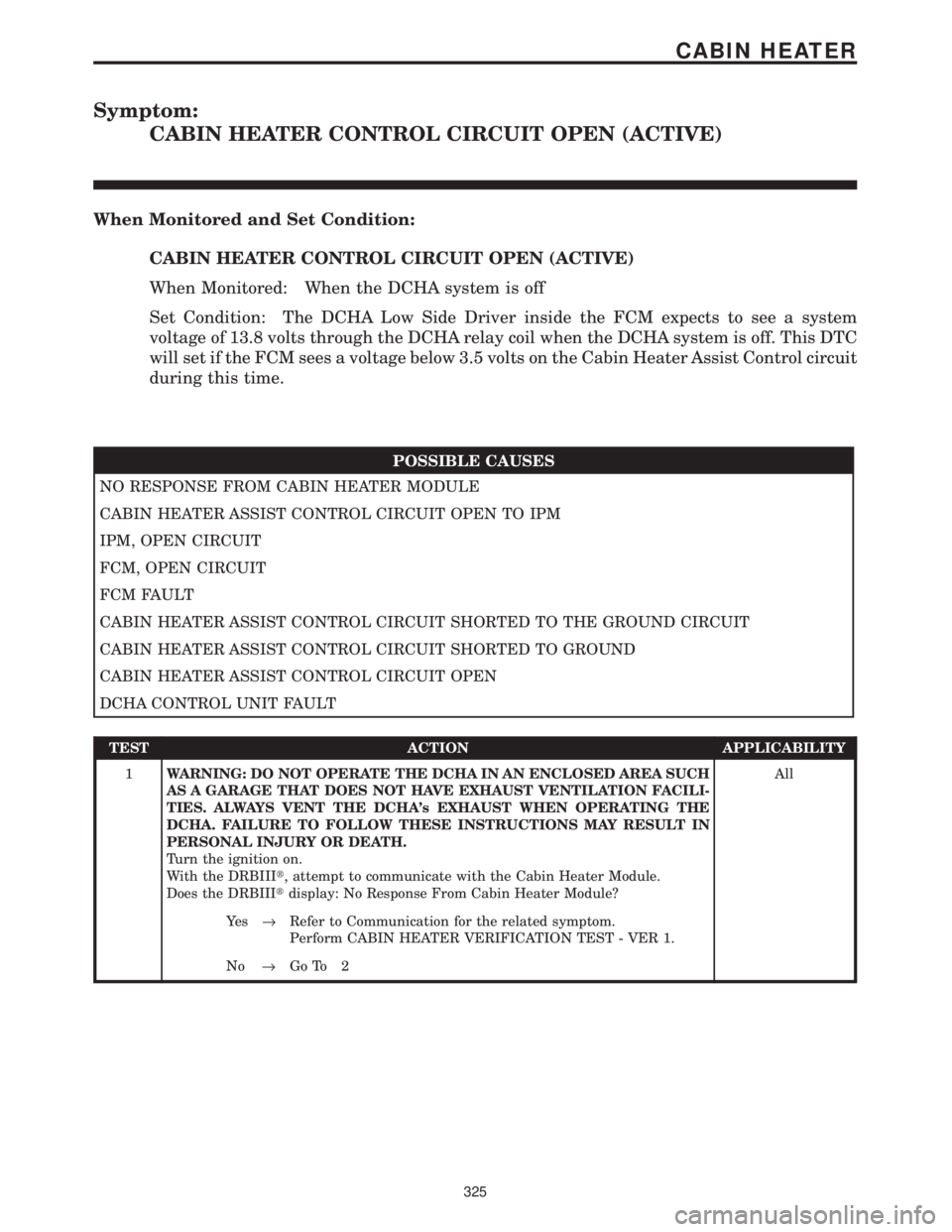
Symptom:
CABIN HEATER CONTROL CIRCUIT OPEN (ACTIVE)
When Monitored and Set Condition:
CABIN HEATER CONTROL CIRCUIT OPEN (ACTIVE)
When Monitored: When the DCHA system is off
Set Condition: The DCHA Low Side Driver inside the FCM expects to see a system
voltage of 13.8 volts through the DCHA relay coil when the DCHA system is off. This DTC
will set if the FCM sees a voltage below 3.5 volts on the Cabin Heater Assist Control circuit
during this time.
POSSIBLE CAUSES
NO RESPONSE FROM CABIN HEATER MODULE
CABIN HEATER ASSIST CONTROL CIRCUIT OPEN TO IPM
IPM, OPEN CIRCUIT
FCM, OPEN CIRCUIT
FCM FAULT
CABIN HEATER ASSIST CONTROL CIRCUIT SHORTED TO THE GROUND CIRCUIT
CABIN HEATER ASSIST CONTROL CIRCUIT SHORTED TO GROUND
CABIN HEATER ASSIST CONTROL CIRCUIT OPEN
DCHA CONTROL UNIT FAULT
TEST ACTION APPLICABILITY
1WARNING: DO NOT OPERATE THE DCHA IN AN ENCLOSED AREA SUCH
AS A GARAGE THAT DOES NOT HAVE EXHAUST VENTILATION FACILI-
TIES. ALWAYS VENT THE DCHA's EXHAUST WHEN OPERATING THE
DCHA. FAILURE TO FOLLOW THESE INSTRUCTIONS MAY RESULT IN
PERSONAL INJURY OR DEATH.
Turn the ignition on.
With the DRBIIIt, attempt to communicate with the Cabin Heater Module.
Does the DRBIIItdisplay: No Response From Cabin Heater Module?All
Ye s®Refer to Communication for the related symptom.
Perform CABIN HEATER VERIFICATION TEST - VER 1.
No®Go To 2
325
CABIN HEATER
Page 358 of 4284
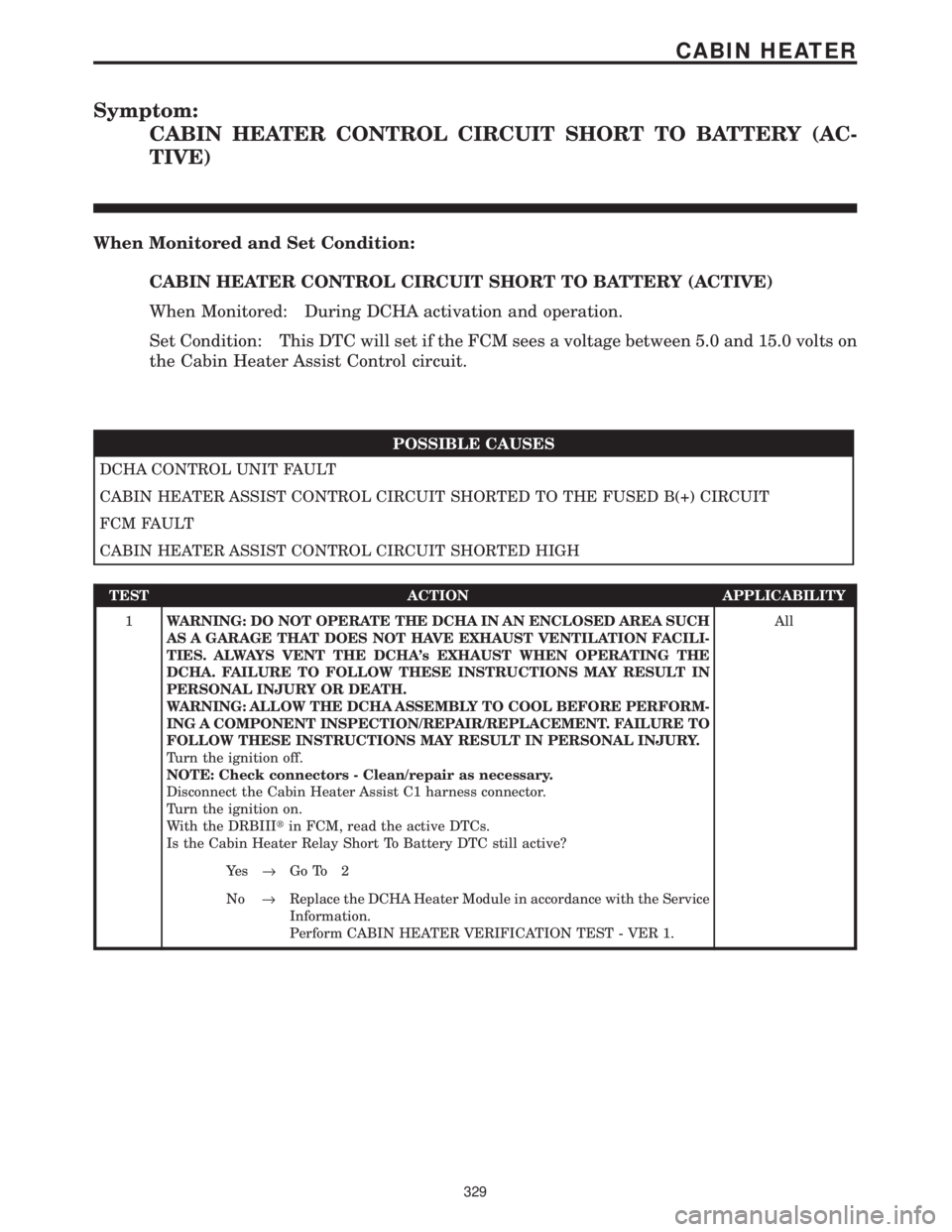
Symptom:
CABIN HEATER CONTROL CIRCUIT SHORT TO BATTERY (AC-
TIVE)
When Monitored and Set Condition:
CABIN HEATER CONTROL CIRCUIT SHORT TO BATTERY (ACTIVE)
When Monitored: During DCHA activation and operation.
Set Condition: This DTC will set if the FCM sees a voltage between 5.0 and 15.0 volts on
the Cabin Heater Assist Control circuit.
POSSIBLE CAUSES
DCHA CONTROL UNIT FAULT
CABIN HEATER ASSIST CONTROL CIRCUIT SHORTED TO THE FUSED B(+) CIRCUIT
FCM FAULT
CABIN HEATER ASSIST CONTROL CIRCUIT SHORTED HIGH
TEST ACTION APPLICABILITY
1WARNING: DO NOT OPERATE THE DCHA IN AN ENCLOSED AREA SUCH
AS A GARAGE THAT DOES NOT HAVE EXHAUST VENTILATION FACILI-
TIES. ALWAYS VENT THE DCHA's EXHAUST WHEN OPERATING THE
DCHA. FAILURE TO FOLLOW THESE INSTRUCTIONS MAY RESULT IN
PERSONAL INJURY OR DEATH.
WARNING: ALLOW THE DCHA ASSEMBLY TO COOL BEFORE PERFORM-
ING A COMPONENT INSPECTION/REPAIR/REPLACEMENT. FAILURE TO
FOLLOW THESE INSTRUCTIONS MAY RESULT IN PERSONAL INJURY.
Turn the ignition off.
NOTE: Check connectors - Clean/repair as necessary.
Disconnect the Cabin Heater Assist C1 harness connector.
Turn the ignition on.
With the DRBIIItin FCM, read the active DTCs.
Is the Cabin Heater Relay Short To Battery DTC still active?All
Ye s®Go To 2
No®Replace the DCHA Heater Module in accordance with the Service
Information.
Perform CABIN HEATER VERIFICATION TEST - VER 1.
329
CABIN HEATER
Page 445 of 4284

Symptom:
*NO RESPONSE FROM RADIO
POSSIBLE CAUSES
NO RESPONSE FROM RADIO
OPEN FUSED ACCESSORY RELAY OUTPUT CIRCUIT
OPEN FUSED B+ CIRCUIT
RADIO GROUND CIRCUIT OPEN
OPEN PCI BUS CIRCUIT
RADIO
TEST ACTION APPLICABILITY
1 Turn the ignition on.
Note: As soon as one or more module communicates with the DRB, answer
the question.
With the DRB, attempt to communicate with the Airbag Control Module (ACM).
With the DRB, attempt to communicate with the Body Control Module (BCM).
Was the DRB able to I/D or establish communications with either of the modules?All
Ye s®Go To 2
No®Refer to the Communications category and perform the symptom
PCI Bus Communication Failure.
Perform BODY VERIFICATION TEST - VER 1.
2 Turn the ignition off.
Disconnect the Radio C1 harness connector.
Turn the ignition on.
Using a 12-volt test light connected to ground, probe the Fused Accessory Relay
Output circuit.
Is the test light illuminated?All
Ye s®Go To 3
No®Check fuse #5 in the IPM for an open. If ok, repair the Fused
Accessory Relay Output circuit for an open or short. Refer to the
wiring diagrams located in the Service Information.
Perform BODY VERIFICATION TEST - VER 1.
3 Turn the ignition off.
Disconnect the Radio C1 harness connector.
Using a 12-volt test light connected to ground, probe the Fused B+ circuit.
Is the test light illuminated?All
Ye s®Go To 4
No®Check fuse #14 in the IPM for an open. If ok, repair the Fused B+
circuit for an open or short. Refer to the wiring diagrams located
in the Service Information.
Perform BODY VERIFICATION TEST - VER 1.
416
COMMUNICATION
Page 450 of 4284

TEST ACTION APPLICABILITY
3 Turn the ignition off.
Disconnect the TCM harness connector.
Remove the starter relay from the IPM.
Using a 12-volt test light connected to ground, probe the Ignition Switch Output
(Start) circuit.
Note: The light must illuminate brightly, if it does not light, or lights dimly,
the circuit must be repaired. If there is any doubt, compare the brightness
when testing the circuit, to the brightness when connected directly to the
battery positive post.
Observe the test light while momentarily turning the ignition switch to the Start
position.
Is the test light illuminated?All
Ye s®Go To 4
No®Repair the Ignition Switch Output (Start) circuit for an open.
Refer to the wiring diagrams located in the Service Information.
Perform 41TE TRANSMISSION VERIFICATION TEST - VER 1.
Note: Reinstall the original Starter Relay.
4 Turn the ignition off.
Disconnect the TCM harness connector.
Using a 12-volt test light connected to ground, probe the Fused B(+) circuit.
Note: The light must illuminate brightly, if it does not light, or lights dimly,
the circuit must be repaired. If there is any doubt, compare the brightness
when testing the circuit, to the brightness when connected directly to the
battery positive post.
Is the test light illuminated?All
Ye s®Go To 5
No®Check IPM fuse #15 for an open. If OK, repair the Fused B(+)
circuit for an open. Refer to the wiring diagrams located in the
Service Information.
Perform 41TE TRANSMISSION VERIFICATION TEST - VER 1.
5 Turn the ignition off.
Disconnect the TCM harness connector.
Using a 12-volt test light connected to 12-volts, probe each ground circuit in the TCM
connector.
NOTE: The light must illuminate brightly, if it does not light, or lights dimly,
the circuit must be repaired. If there is any doubt, compare the brightness
when testing the circuit, to the brightness when connected directly to the
battery negative post.
Is the light illuminated at all ground circuits?All
Ye s®Go To 6
No®Repair the Ground circuit(s) for an open. Check the main ground
connection to engine block and/or chassis. Refer to the wiring
diagrams located in the Service Information.
Perform 41TE TRANSMISSION VERIFICATION TEST - VER 1.
421
COMMUNICATION
*NO RESPONSE FROM TRANSMISSION CONTROL MODULE ÐContinued
Page 469 of 4284

Symptom:
EBL RUN ONLY RELAY OPEN
When Monitored and Set Condition:
EBL RUN ONLY RELAY OPEN
When Monitored: Continuously with the ignition on.
Set Condition: The FCM has detected an open in the Rear Defogger Relay control circuit.
POSSIBLE CAUSES
OPEN B+ TO RELAY
VERIFY ACTIVE DTC
MISSING RELAY
FRONT CONTROL MODULE
REAR WINDOW DEFOGGER RELAY
INTELLIGENT POWER MODULE
TEST ACTION APPLICABILITY
1 Turn the ignition on.
With the DRBIIIt, erase the current Front Control Module DTC's.
Turn the ignition off, wait 10 seconds then turn the ignition on.
With the DRBIIIt, read the current Front Control Module DTC's.
Does the DRBIIItdisplay EBL RUN ONLY RELAY OPEN trouble code?All
Ye s®Go To 2
No®The condition that caused this symptom is currently not present
at this time.
Perform BODY VERIFICATION TEST - VER 1.
2 Turn the ignition off.
Check the IPM to make certain the Rear Window Defogger Relay is present.
Is the Rear Window Defogger Relay present?All
Ye s®Go To 3
No®Replace the missing Rear Defogger Relay.
Perform BODY VERIFICATION TEST - VER 1.
3 Remove the Rear Window Defogger relay from the IPM.
Measure the voltage of pin 86 in the Rear Defogger Relay socket.
Is the voltage above 10.0 volts?All
Ye s®Go To 4
No®Repair/replace open B+ to relay as necessary.
Perform BODY VERIFICATION TEST - VER 1.
440
ELECTRICALLY HEATED SYSTEMS
Page 470 of 4284
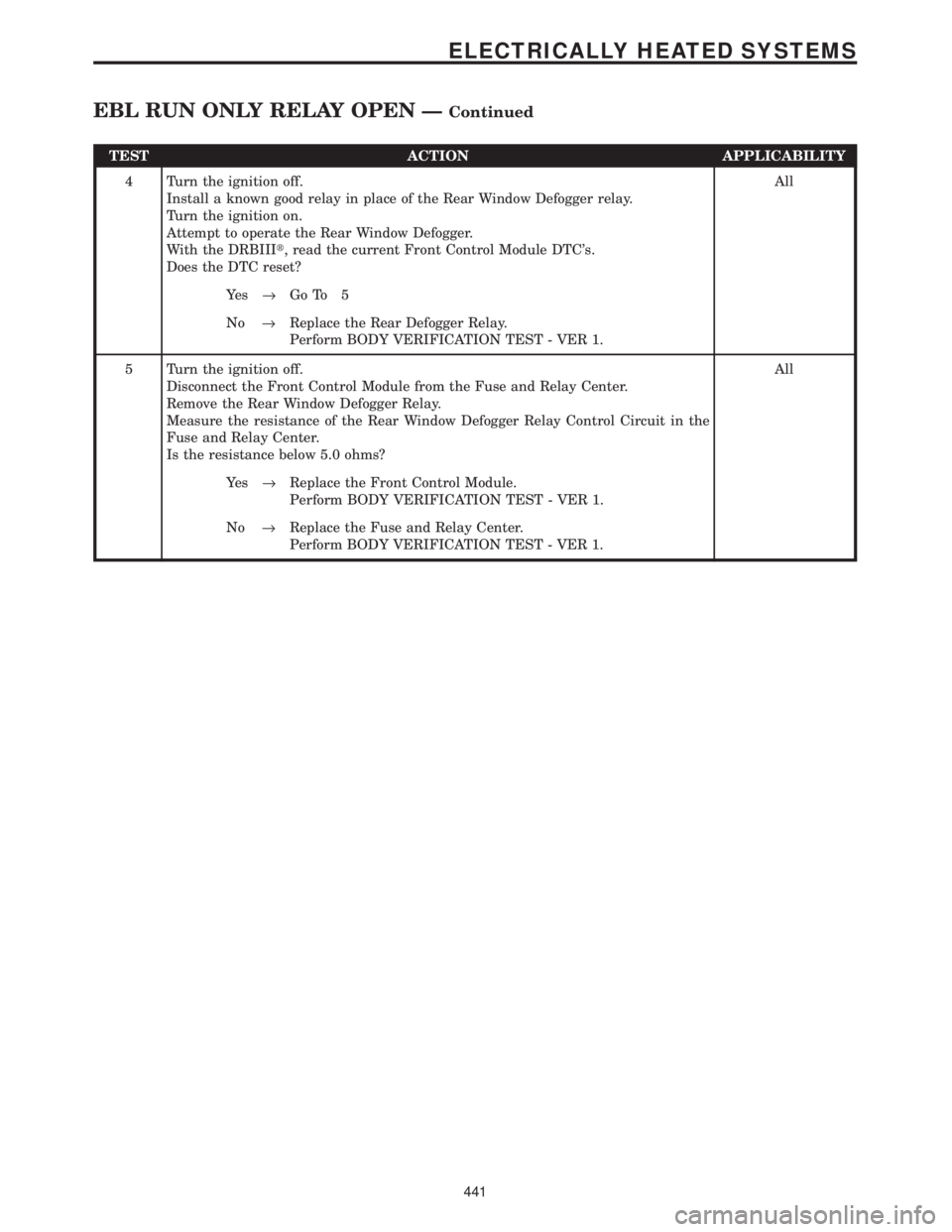
TEST ACTION APPLICABILITY
4 Turn the ignition off.
Install a known good relay in place of the Rear Window Defogger relay.
Turn the ignition on.
Attempt to operate the Rear Window Defogger.
With the DRBIIIt, read the current Front Control Module DTC's.
Does the DTC reset?All
Ye s®Go To 5
No®Replace the Rear Defogger Relay.
Perform BODY VERIFICATION TEST - VER 1.
5 Turn the ignition off.
Disconnect the Front Control Module from the Fuse and Relay Center.
Remove the Rear Window Defogger Relay.
Measure the resistance of the Rear Window Defogger Relay Control Circuit in the
Fuse and Relay Center.
Is the resistance below 5.0 ohms?All
Ye s®Replace the Front Control Module.
Perform BODY VERIFICATION TEST - VER 1.
No®Replace the Fuse and Relay Center.
Perform BODY VERIFICATION TEST - VER 1.
441
ELECTRICALLY HEATED SYSTEMS
EBL RUN ONLY RELAY OPEN ÐContinued
Page 471 of 4284
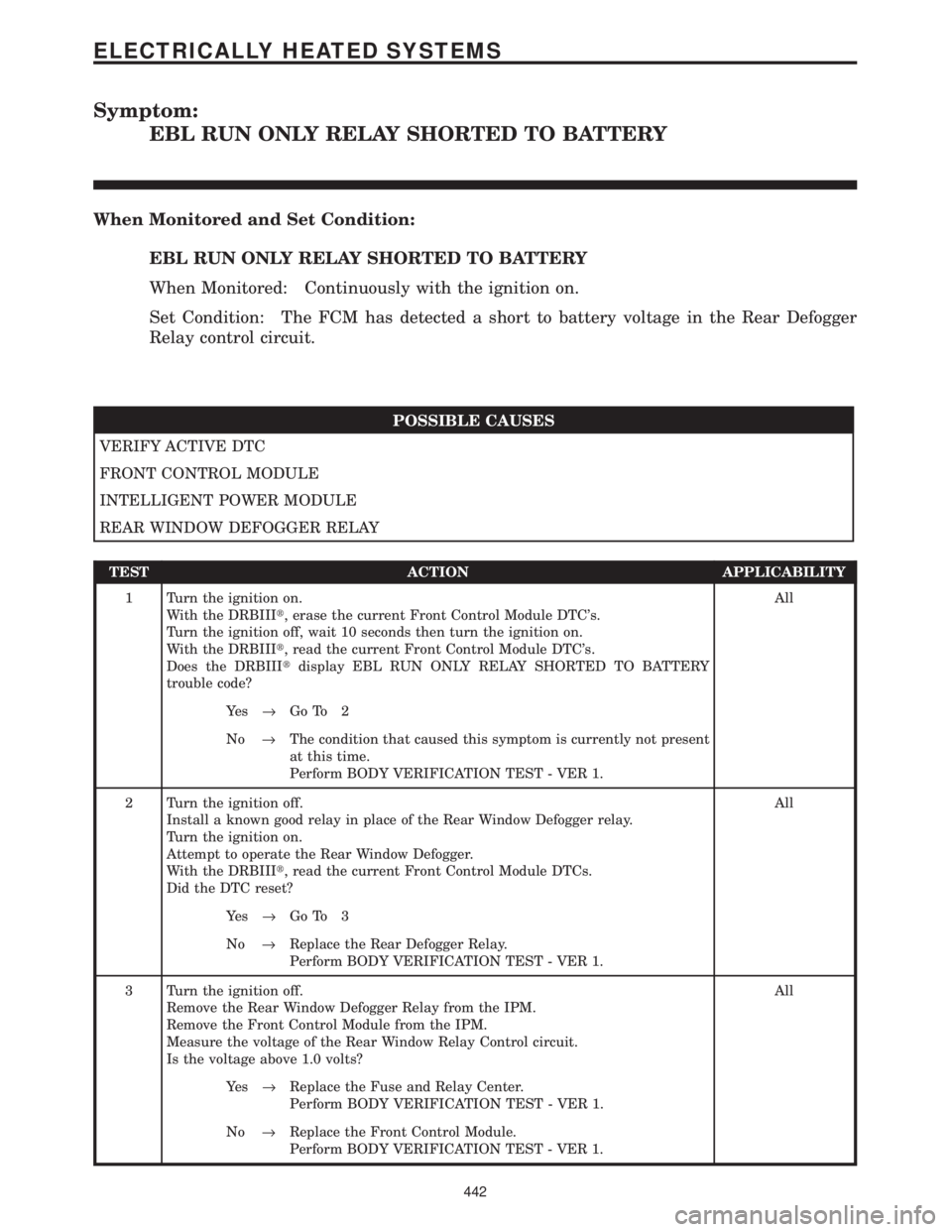
Symptom:
EBL RUN ONLY RELAY SHORTED TO BATTERY
When Monitored and Set Condition:
EBL RUN ONLY RELAY SHORTED TO BATTERY
When Monitored: Continuously with the ignition on.
Set Condition: The FCM has detected a short to battery voltage in the Rear Defogger
Relay control circuit.
POSSIBLE CAUSES
VERIFY ACTIVE DTC
FRONT CONTROL MODULE
INTELLIGENT POWER MODULE
REAR WINDOW DEFOGGER RELAY
TEST ACTION APPLICABILITY
1 Turn the ignition on.
With the DRBIIIt, erase the current Front Control Module DTC's.
Turn the ignition off, wait 10 seconds then turn the ignition on.
With the DRBIIIt, read the current Front Control Module DTC's.
Does the DRBIIItdisplay EBL RUN ONLY RELAY SHORTED TO BATTERY
trouble code?All
Ye s®Go To 2
No®The condition that caused this symptom is currently not present
at this time.
Perform BODY VERIFICATION TEST - VER 1.
2 Turn the ignition off.
Install a known good relay in place of the Rear Window Defogger relay.
Turn the ignition on.
Attempt to operate the Rear Window Defogger.
With the DRBIIIt, read the current Front Control Module DTCs.
Did the DTC reset?All
Ye s®Go To 3
No®Replace the Rear Defogger Relay.
Perform BODY VERIFICATION TEST - VER 1.
3 Turn the ignition off.
Remove the Rear Window Defogger Relay from the IPM.
Remove the Front Control Module from the IPM.
Measure the voltage of the Rear Window Relay Control circuit.
Is the voltage above 1.0 volts?All
Ye s®Replace the Fuse and Relay Center.
Perform BODY VERIFICATION TEST - VER 1.
No®Replace the Front Control Module.
Perform BODY VERIFICATION TEST - VER 1.
442
ELECTRICALLY HEATED SYSTEMS